
Sri Lanka has several traditional games and sports, many of which are played during the Aluth Avurudda festival. [1] [2] Some of these games are similar to other traditional South Asian games.

Sri Lanka has several traditional games and sports, many of which are played during the Aluth Avurudda festival. [1] [2] Some of these games are similar to other traditional South Asian games.
In Ankeliya, two horns are attached to a strong tree, and then a rope is thrown across both horns. Two teams tug at the opposite ends of the rope until one of the horns breaks off. [3] [2]
Batta is a form of hopscotch in which players must hop through various boxes while moving a stone forward through the boxes. Stepping on the ground with a disallowed foot, stepping on the lines between the boxes, or moving the stone into a disallowed area causes a player to lose. [4]
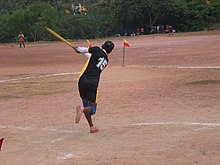
Gudu keliya is a variation of gilli-danda in which one player attempts to knock a small stick on the ground up into the air by hitting it with a longer stick held in the hand, and then tries to hit the small stick as far as possible. [5] Opponents can catch the small stick before it touches the ground to make the hitter lose. [3] [2]
Kotta Pora is a pillow-fighting game in which two opponents sit on top of a pole which is balanced off the ground. Both players must keep one hand behind their back and, using a pillow held with the other hand, attempt to knock the opponent off the pole. [6] [3] [7]
Players must attempt to break water-filled pots that are suspended off the ground with a stick while blindfolded. [6] [3] [7]
In this game, the players of two teams throw coconuts at each other, and use their own coconuts to block the coconuts thrown at them. As the game progresses, some of the coconuts eventually break, and by the end of the game, the team with the most intact coconuts wins. [8]
Kili Thadthu (related to the Tamil game of Killithattu) is a game in which two teams of six players compete in periods of seven minutes, with the teams alternating offense and defense in each period. To score, the attacking team's players must make it across the entire field without being tagged by the defensive players, who stand on lines drawn horizontally across the field. [6]


Angampora is a Sinhalese martial art that combines combat techniques, self-defense, sport, exercise, and meditation. [12] [13] A key component of angampora is the namesake angam, which incorporates hand-to-hand fighting, and illangam, involving the use of indigenous weapons such as the ethunu kaduwa, staves, knives and swords. [14] [15] Another component known as maya angam, which uses spells and incantations for combat, is also said to have existed. [16] Angampora's distinct feature lies in the use of pressure point attacks to inflict pain or permanently paralyze the opponent. Fighters usually make use of both striking and grappling techniques, and fight until the opponent is caught in a submission lock that they cannot escape. Usage of weapons is discretionary. Perimeters of fighting are defined in advance, and in some of the cases is a pit. [16] [17]
A number of paintings related to angampora are found at Buddhist temples in Sri Lanka. These include Embekka Devalaya, Gadaladeniya Rajamaha Viharaya, Temple of the Tooth, Saman Devalaya (Ratnapura) and Lankathilaka Rajamaha Viharaya. [18] [19]
Peralikatuma is a two-player abstract strategy board game from Sri Lanka (formerly called Ceylon). It is a game related to draughts (checkers) and alquerque as players hop over one another's pieces when capturing them. The game was documented by Henry Parker in Ancient Ceylon: An Account of the Aborigines and of Part of the Early Civilisation (1909) with the name perali kotuwa or the war enclosure. [20] Parker mentions that it is also played in India. It closely resembles another game from Sri Lanka called Kotu Ellima. The two games use the same board which consist of a standard alquerque board but with four triangular boards attach to its four sides. The only difference between the two games is in the number of pieces. In peralikatuma, each player has 23 pieces. In Kotu Ellima, each player has 24 pieces.
The game is also spelled as perali kotuma.
The Sinhalese people, also known as the Sinhalese or Sinhala people are an Indo-Aryan ethno-linguistic group native to the island of Sri Lanka. They are the largest ethnic group in Sri Lanka, constituting about 75% of the Sri Lankan population and number more than 15.2 million.
The music of Sri Lanka has its roots in five primary influences: ancient folk rituals, Hindu religious traditions, Buddhist religious traditions, the legacy of European colonisation, and the commercial and historical influence of nearby Indian culture—specifically, Kollywood cinema and Bollywood cinema.
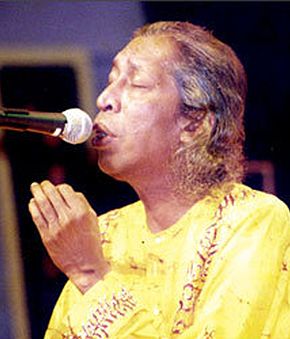
Ellamulla Kapuge Gunadasa popularly known as Gunadasa Kapuge, was a Sri Lankan singer, musician, music director and playback singer. He was well known among Sri Lankans due to the philosophical background of his music renditions and lyrics selected for his work.
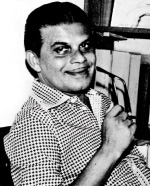
Karunaratne Abeysekera was one of Sri Lanka's most famous Sinhala broadcasters. He was also a poet and songwriter and was widely admired for his excellent command of Sinhala.
Pattini, is considered a guardian deity of Sri Lanka in Sri Lankan Buddhism and Sinhalese folklore. She is also worshipped by Sri Lankan Tamil Hindus by the name of Kannaki Amman.
Cricket was introduced to Sri Lanka in the first quarter of the 19th century, following colonisation of the island by the British. The earliest known match was recorded in 1832 and the earliest first-class one in 1926. The national team has played Test cricket from 1982. The national team has achieved international success by winning the 1996 Cricket World Cup and the 2014 ICC World Twenty20. Cricket is played nationwide with Test venues in Colombo, Galle, Kandy and Moratuwa. The country's most notable players include Aravinda de Silva, Arjuna Ranatunga, Rangana Herath, Sanath Jayasuriya, Mahela Jayawardene, Muttiah Muralitharan, Kumar Sangakkara and Chaminda Vaas. Administration and governance are performed by Sri Lanka Cricket, which was founded in July 1922 as the Ceylon Cricket Association (CCA). The main domestic competition is the Premier Trophy which attained first-class status in 1988.
Rajasinghe I also known as the lion of Sitawaka was a king of Sitawaka, known for his patriotism and fight against the Portuguese invasion of Sri Lanka. Born as Tikiri Bandara to King Mayadunne, he received the name "Rajasimha" after the fierce Battle of Mulleriyawa.

Peralikatuma is a two-player abstract strategy board game from Sri Lanka. It is a game related to draughts (checkers) and alquerque as players hop over one another's pieces when capturing them. The game was documented by Henry Parker in Ancient Ceylon: An Account of the Aborigines and of Part of the Early Civilisation (1909) with the name perali kotuwa or the war enclosure. Parker mentions that it is also played in India. It closely resembles another game from Sri Lanka called Kotu Ellima. The two games use the same board which consist of a standard alquerque board but with four triangular boards attach to its four sides. The only difference between the two games is in the number of pieces. In peralikatuma, each player has 23 pieces. In Kotu Ellima, each player has 24 pieces.
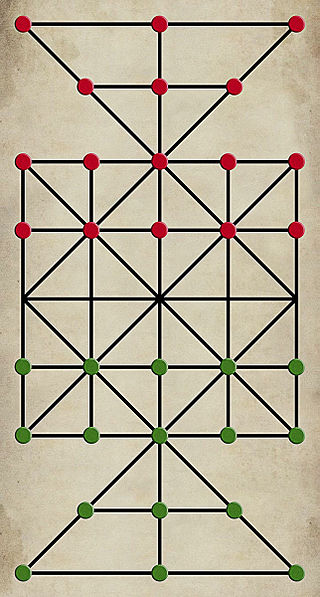
Sixteen soldiers is a two-player abstract strategy board game from Sri Lanka. It also comes from India under the name cows and leopards. A variant of this game is also popular in Bangladesh, where it is known as sholo guti. One way it is played, is by drawing the court of the game on the ground and using stones as pawns.
Kotu Ellima is a two-player abstract strategy board game from Sri Lanka played by the Sinhalese people. The game was documented by Henry Parker in Ancient Ceylon: An Account of the Aborigines and of Part of the Early Civilisation (1909); the game was printed as "Kotu Ellima" which is actually a misspelling because his source for the game was Leopold Ludovici's Journal of the Ceylon Branch of the Royal Asiatic Society (1873), and specifically in the chapter entitled "The Sports and Games of the Singhalese", and Ludovici wrote the name of the game as Kotu Ellime or Taking of the Castles. The game is similar to draughts (checkers) and Alquerque as players hop over one another's pieces to capture them; it is more similar to Alquerque between the two since it uses a standard Alquerque board. However, unlike draughts and standard Alquerque, the game is played on an expanded Alquerque board consisting of four triangular boards attached to the four sides of a standard Alquerque board. It closely resembles peralikatuma and sixteen soldiers which are also played in Sri Lanka and other parts of the Indian subcontinent with the only difference being the number of pieces. In sixteen soldiers, each player has 16 pieces hence the name of the game. In peralikatuma, each player has 23 pieces. In Kotu Ellima, each player has 24 pieces, and at the beginning of the game the whole board is covered with them except the central point reminiscent of standard alquerque.
The Battle of Mulleriyawa in 1559 was part of the Sinhalese–Portuguese War. It was one of the most decisive battles in Sri Lankan history and considered as the worst defeat of Portuguese during that period. According to local chronicles the marshlands of Mulleriyawa turned red with blood after the annihilation of the Portuguese. With this victory Sitawaka emerged as a military power which was able to challenge the Portuguese expansion.
Sport in Sri Lanka is a significant part of Sri Lankan culture. Although the Sports Ministry named volleyball the national sport, the most popular sport is Cricket. Rugby union is also popular. Other popular sports are water sports, badminton, athletics, football, basketball and tennis. Sri Lanka's schools and colleges regularly organize sports and athletics teams, competing on provincial and national levels.
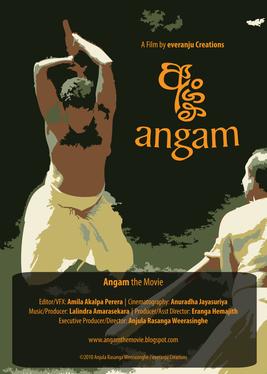
Angam is a documentary film made in 2010 about Sri Lankan history and the survival of its traditional martial art, angampora. It was produced and directed by Rasanga Weerasinghe. The film explores the origins of Sri Lankan civilization, and the vital role Angampora has played in its history, up to the present day. The film was released in 2011 at Goethe Institute, Colombo, as a private screening organized by the filmmakers.

Dinesh Subasinghe is a Sri Lankan composer, violinist, and music producer. He composed Karuna Nadee, a Buddhist oratorio, and re-introduced a lost, ancient musical instrument known as the ravanahatha to Sri Lanka. He is also a film and television composer whose works integrate western and eastern classical music with electronic music, Buddhist music, folk music, traditional orchestral arrangements, and world music genres. From 2002 to 2009 he led the pop classical band, Dee R Cee Members.

Angampora is a Sinhalese martial art that combines combat techniques, self-defense, sport, exercise, and meditation. A key component of angampora is the namesake angam, which incorporates hand-to-hand fighting, and illangam, involving the use of indigenous weapons such as the ethunu kaduwa, staves, knives and swords. Another component known as maya angam, which uses spells and incantations for combat, is also said to have existed. Angampora's distinct feature lies in the use of pressure point attacks to inflict pain or permanently paralyze the opponent. Fighters usually make use of both striking and grappling techniques, and fight until the opponent is caught in a submission lock that they cannot escape. Usage of weapons is discretionary. Perimeters of fighting are defined in advance, and in some of the cases is a pit.

Cheena di, or Cheenaadi, or occasionally, Chinna ati / Chaina pudi; and in Malayalam Cheena Adi, is a Chinese-derived martial art in Sri Lanka. Another viewpoint, due to self-proclaimed Cheena di Master Gunadasa Subasinghe is that the word Cheena di comes from Chennai (A)di, a martial art originally taught by Indian Immigrants in Sri Lanka to their eventually street-fighting disciples called Chandi of diverse native ethnicities, including the Sinhalese, Muslims, as well as Sri Lanka Tamils, all living in the same poor-ish neighbourhoods.
Bibiladeniye Mahanama Thero is a Buddhist monk of the Theravada Order. The thero is the only Buddhist priest in Asia of the Theravada order to actively engage in the experimentation and the creative exploration of music as a form of aesthetic expression. The thero has been actively engaged with the art, both on overseas projects as well as in Sri Lanka for nearly two decades.
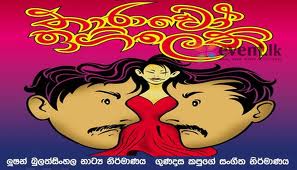
Tharawo Igilethi is a Sinhalese stage drama by Lucien Bulathsinhala, based on the twin brothers story on Singapore Country. This drama is directed and produced by Lucien Bulathsinhala. The play made a comeback after ten years as a new production in 2018. Music is produced by Gunadasa Kapuge.
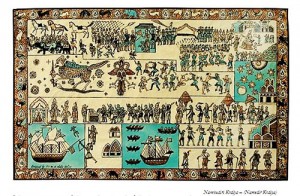
Maggona Arachchi is a Sinhalese speaking Khandayat ethnic group of Sri Lanka. The House of Kaikesi Irugal migrated from Odisha in the 13th Century, claiming lineage to the Yadava royalty in the Kingdom of Kalinga in Eastern India. They are probably related to Khandayat people.
Hat diviyan keliya.